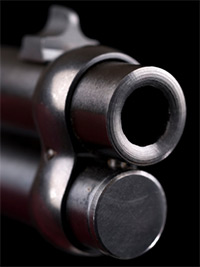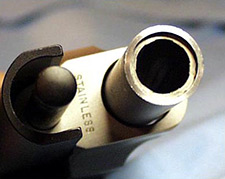Home | Glossary | Resources | Help | Contact Us | Course Map
Archival Notice
This is an archive page that is no longer being updated. It may contain outdated information and links may no longer function as originally intended.
Contouring/Profiling
Most rifled barrels come off the machinery with a straight and oversized external profile. For some barrels, solid protrusions must be left after completion to allow for sight mounting or bearing lugs. Finish machining produces these features, using the precisely aligned bore as the index point.
Most sporting rifles have a tapered barrel for aesthetics and weight reduction. These are commonly profiled by lathe-turning after rifling. For an accurate barrel, the metal must be exactly the same thickness at every point along its length. Failing to observe this tenet of barrel making will result in asymmetrical stresses and vibration during firing. Again, a precisely placed borehole (index point) is the basis for barrel symmetry.
The finishing operation that can affect the examiners ability to compare a bullet to a barrel is crowning the muzzle (bullet exit point). If a barrel is left with a perfectly flat muzzle, the edges of the rifling are exposed to the potential for mechanical damage. Accidentally striking the end of the barrel against a rock or other hard surface can create burrs. These defects can negatively affect the exit of the bullet from the barrel by degrading accuracy, thus shifting the point of impact. To avoid such damage, barrel makers recess the rifling through crowning.
In its simplest form, crowning can be accomplished with a countersink drill. However, a coarse countersink can also leave burrs. Crowning is frequently accomplished with a shaped mild steel lap covered in fine grinding paste. Target arms are often fitted with a machined, flat-bottom recess that leaves the rifling edges sharp but slightly below the end of the barrel for protection.
Any crowning operation can contribute to individual marks that will characterize a bullet. If this occurs, it is a function of the method of rifling, the barrel material, and the crowning method.
Chambering and Throating
All cartridge firearms, except revolvers, require the enlargement of the rear portion of the bore to accept a cartridge. The enlarged section is the chamber. For a cartridge with relatively straight sidewalls close to bore diameter (e.g., 30 US Carbine), a chamber reamer can produce the finished chamber in one operation. However, for bottleneck cartridges (e.g., 30-06 Springfield), the main body of the chamber can be twice the bore diameter. Removing this extra material rapidly with low-cost tooling saves wear to expensive chamber reamers. Less expensive roughing reamers can be used or the chamber can be roughed out by other methods. Step drilling with standard twist drills or the formation of a partial chamber in a hammer-forged barrel accomplishes the goal of preserving critical finishing reamers.
The intersection of the chamber with the rifling must be carefully tapered to reduce the engraving forces on a fired bullet. This area of the barrel is the throat. For mass-produced commercial and military firearms, the throating reamer is commonly an integral part of the chambering reamer. For special throating needs, separate throating reamers may be used. Nonstandard throating is usually the realm of the custom gunsmith. Throat dimensions for standard cartridges are specified in industry barrel/chamber drawings.
Additional Online Courses
- What Every First Responding Officer Should Know About DNA Evidence
- Collecting DNA Evidence at Property Crime Scenes
- DNA – A Prosecutor’s Practice Notebook
- Crime Scene and DNA Basics
- Laboratory Safety Programs
- DNA Amplification
- Population Genetics and Statistics
- Non-STR DNA Markers: SNPs, Y-STRs, LCN and mtDNA
- Firearms Examiner Training
- Forensic DNA Education for Law Enforcement Decisionmakers
- What Every Investigator and Evidence Technician Should Know About DNA Evidence
- Principles of Forensic DNA for Officers of the Court
- Law 101: Legal Guide for the Forensic Expert
- Laboratory Orientation and Testing of Body Fluids and Tissues
- DNA Extraction and Quantitation
- STR Data Analysis and Interpretation
- Communication Skills, Report Writing, and Courtroom Testimony
- Español for Law Enforcement
- Amplified DNA Product Separation for Forensic Analysts




